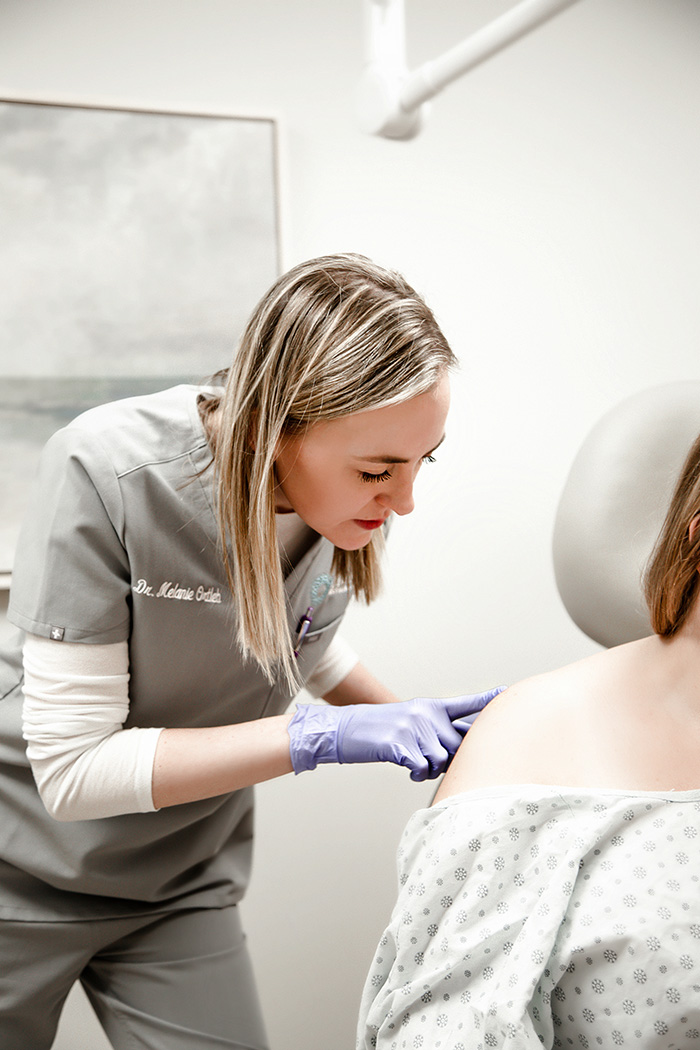Dermatitis & Skin Rash Treatment near Fremont, NE
If you suffer from skin rashes or dermatitis, you might experience discomfort during your daily activities, as well as feelings of lower self-esteem if your skin issues are prevalent. While there are many options for non-prescription skin rash treatments, those generalized products aren’t always effective. A certified dermatologist can evaluate your skin rash and will be able to perform the correct treatment for your specific type of dermatitis.
Our certified dermatologists at MOD Dermatology have extensive experience with dermatitis and skin rash treatment in Fremont. Whether you suffer from rashes due to herpes labialis, shingles, drug eruptions, or other conditions, our office can provide effective treatments. Call today to schedule a consultation.

Available Skin Rash & Dermatitis Treatments
Our office offers skin treatments for Fremont residents who suffer from dermatitis and prevalent or recurring rashes that result from any of the following conditions:
- Cutaneous lupus, including subacute cutaneous lupus, discoid lupus, and lupus panniculitis
- Lichen Planus
- Pemphigus vulgaris, bullous pemphigoid, and other autoimmune blistering diseases
- Dermatomyositis
- Graft vs. Host Disease
- Morphea and Scleroderma
- Drug Eruptions
- Herpes Labialis
- Erythema Multiforme
- Toxic Epidermal Necrolysis and Stevens-Johnson Syndrome
- Shingles
What is Dermatitis?
Dermatitis is a general term used to describe several types of skin rashes. Several factors, including genetics, an overactive immune system, infections, or allergies, may cause these rashes. Excessive redness or uncomfortable itchiness in an area may indicate a skin rash. Depending on the type of dermatitis you are experiencing, there are a variety of safe and effective skin treatments your dermatologist may recommend.
The different types of dermatitis:
Also known as eczema, atopic dermatitis refers to a skin condition in which the affected area becomes itchy and inflamed. While most common in younger children, it can affect a person at any age. Thankfully, atopic dermatitis is not contagious. Atopic dermatitis shows up differently in children as opposed to adults. Children often experience rashes in the creases of their elbows and knees. In adults, this skin condition can be experienced anywhere but often shows up on the hands, creases of the elbow, neck, knees, ankles, feet, and surrounding the eyes.
Atopic dermatitis can cause some unwanted symptoms, including loss of sleep due to itchiness, infection from excessive scratching, or a negative effect on one's self-esteem and mental health. Those who are most affected by atopic dermatitis include people with a family history of eczema or related conditions, living in an environment with allergens, such as mold or dust, or having a weak skin barrier.
Contact dermatitis occurs when skin comes in contact with a substance that causes an allergic reaction. This skin condition causes an itchy rash to occur, often coupled with dry and scale-like patches of skin. Common products that cause reactions include cosmetics, chemicals, certain jewelry, and other substances. A majority of skin treatments for contact dermatitis involve preventative care. By determining the triggering products that cause your skin to develop this condition, you can avoid them and the negative side effects.
Dyshidrotic eczema is a skin condition in which a rash of itchy blisters develops. These most often show up on the palms, the sides of fingers, the soles of your feet, or on the toes. While there is no specific cure-all, your dermatologist may prescribe an ointment to help deal with the swelling. By avoiding certain triggers such as stress, pollen, excessive moisture, nickel, cobalt, and chromium salts, you can help prevent flare-ups.
Nummular dermatitis is a type of common eczema characterized by round, raised spots on the skin that are itchy and dry. These are most commonly found on the legs, and sometimes the feet, torso, hands, and arms. Over time these lesions can start to grow together and become larger, ranging anywhere from 1 inch to greater than 4 inches. This skin condition is not contagious but can be brought about through an injury, such as a cut, bug bite, burn, or abrasion. Flare-ups can occur and symptoms continuously return to the same area.
Also known as dandruff, seborrheic dermatitis is a skin condition that causes scaly patches primarily on the scalp. It may also occur in other oil-producing places, such as the face, nose, eyebrows, ears, eyelids, and chest. The affected area may include greasy skin with a white or yellow crust. When found in infants, this skin rash is called a “cradle cap.” While this condition sometimes clears up by itself, your dermatologist may recommend a medicated shampoo or other treatment. Common triggers for seborrheic dermatitis include stress, illness, changes in the seasons, certain medications, and harsh chemicals or products.
Stasis dermatitis occurs in those who experience poor blood flow. Often found in the lower legs, the veins become too weak to transport blood back up to the heart, and fluid starts to leak out and pool up. Swelling, discolored skin, and varicose veins are all symptoms that you might be experiencing with this skin condition. Your legs may start to feel heavy, and it becomes increasingly harder to walk or stand. This condition may occur due to aging, leg injury, blood clots, or surgery.
Get Dermatitis and Skin Rash Treatment in Fremont
If you are a Fremont resident and suffer from dermatitis and skin rashes, there are many effective skin treatments available. Call 402-505-8777 to schedule a visit with any of our providers.




